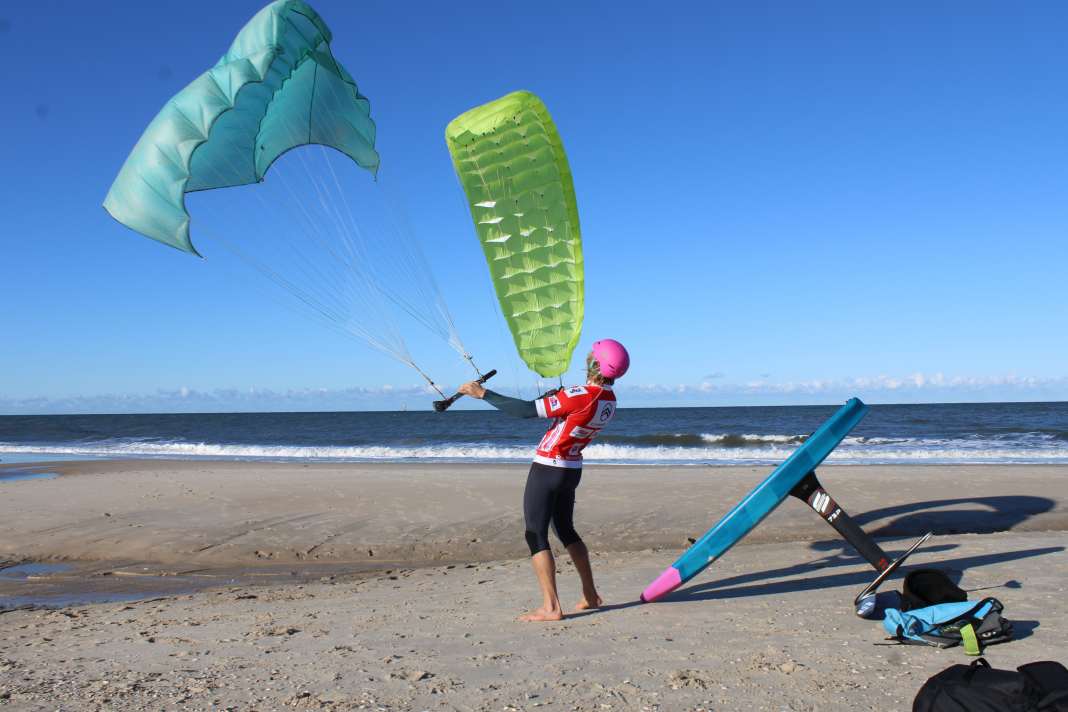Para-Wing: Balz Müller in para-wing fever - "I see an incredible future for this new sport"
Tobias Frauen
· 05.10.2024






People see you on Instagram from time to time, travelling with an Ikea bag or a beach shell. Looking at your mini kite now, it's obviously not that absurd?
Exactly, that has a certain serious background. I'd like to call myself a landlocked surfer, but many people think we don't have waves at home. Personally, I would dispute that; I had the longest waves of my life on Lake Neuchâtel inland. The lake is 42 kilometres long, you can windsurf down the wind waves for about 25 kilometres. And these wind waves have the sensational property that they are actually very small and compact, but they come one after the other. So you always have propulsion. But you always need a paddle or a wing to get onto the foil first. The problem with the wing is that it tends to get in the way when you're actually surfing the waves and you want to weld it away. And that's where the para-wing comes into play: it's actually a paraglider, a small mat dragon with lines about one and a half to two metres long. You can pack it up in a second, tuck it under the lycra and then have your hands free and can concentrate fully on surfing. If you then fall in, you unpack it again, throw it up in the air and bang, you're back on the foil. I think the potential of this is insane. And I see an incredible future for this new sport.
How did you come across it? Where did you see it first?
It was the Hawaiians! A woman called Cynthia Brown didn't like paddling because she had problems with her shoulders. So she took a simple kite, which was not yet steerable, simply threw it up in front of her and got it flying. Then she had the idea of wrapping the kite and did one downwinder after another. That was about two years ago. Back then, nobody really saw the potential in it, then came the pocket wing, which, to put it bluntly, was just a parachute that simply pulls you straight with the wind. And now comes Boardriding Maui with their Maliko, which is actually the first para-wing that you can steer with one hand. It was developed very simply, a small stunt kite with three square metres, and the guys are now taking off with it in Hawaii. I don't think any of them wing anymore, they're all just parawing. It's easy to foil out, pack the thing up, surf back to the beach, throw the para-wing back up, usually even on the foil, go out again and do it all day. I've always watched this, but I didn't think it would work here at the lake. We don't come upwind, we have sideshore wind. I then unpacked my 25-year-old stunt kite again and gave it a go and I was actually able to cross upwind, so I came upwind!
I dream about it during the day, I dream about it at night, I can't get enough of this para-wing stuff
In other words, it really is a children's toy.
It was a child's toy and getting started was much easier than I had imagined. I thought 'Damnit, why isn't anyone doing this yet? Next year will be different. There's so much going on at the moment, all the big brands are going crazy with development. So far, the spaghetti salad is still guaranteed, I've been on the board a lot and had all these lines in a pile. But I'm convinced that we're about to see some incredible developments!
So keeping the lines tidy is the main problem at the moment?
Yes, to hold the lines properly and to develop the kite so efficiently that it also pulls forwards and doesn't just flutter. But the prerequisites are actually already there, there are mat kites that can do all that. Of course, the haters will come back and say 'Just attach 25 metres of line, then you can get out and up easily'. But the highlight is packing it up, stowing it away and then just getting it out again. It haunts me in my sleep. I dream about it during the day, I dream about it at night, I can't get enough of this para-wing stuff (laughs).
Which boards work best for para-swinging?
Currently Midlength boards the topic. My downwind board has always been quite short, actually only a 6'3", because the larger 9-foot boards don't fit between the chop here on the lake. That's why I've always ridden a mid-length downwind board, and I currently use a 70-litre wing board. You can get on the foil so quickly, even 800 square centimetres of front wing is enough, so very small foils. So it doesn't have to be the pure downwind boards. A mid-length board and para-wing on the lake will be absolute madness.
Mid-length board and para-wing on the lake, it's going to be absolutely amazing!
How big should a para-wing be?
The wind range of this para-wing is quite limited. I now usually sail 3 square metres, which is perfect for foiling in the optimum wind range, but if it gets a little less, it becomes very challenging, especially with a small foil. But the clever people simply take a 6 and a 4 para-wing with them at the same time. It doesn't weigh anything, it's a small, compact package. When the wind gets a bit weaker, you throw the bigger one up and stow the smaller one on the harness. I think that's the way to go. You can really foil away with this stuff (laughs).
Is the target group mainly experienced downwind foilers or is it also aimed at beginners?
I think wingfoiling is probably the easier way to get started because it's challenging with the lines and the balance on the board. But the downwind spectrum opens up a whole new world for everyone because you no longer have to paddle. I see huge potential at side shore or side on shore spots where there's a great wave, where you can now foil out with the para-wing and then surf in. And surfing, that's what we all want, simply that feeling of gliding with the foil, being a seagull over the wave, that's the dream of us all. What's more, every child can fly a kite. And it's relatively safe because the para-wing doesn't drift or blow away like a wing. At the moment, it still sinks relatively quickly, but we are also developing safety leashes and other features, so there is a lot to come. New ideas are coming in every day, all brands are in the first stages of development and I'm really excited to see what's in store for us!
Can you give us a glimpse into the future? While we see para-wings everywhere next summer?
There are supposedly only para-wings on the water in Hawaii. And that is the Mecca, the telescope into the future. I'm convinced that you'll see a lot of para-wingers here on the lake next year. I've already para-winged my first tack, my first jibes and my first jumps. I don't know if para-wing freestyle will be a thing, but I've already jumped a 360.
Does that mean the thing also has a bit of buoyancy?
It has the lift of a paraglider! We at Ensis are developing together with a renowned designer from the paragliding industry, who is also a very good winger. He has been losing sleep over the Para-Wing for two months and is in the factory day and night to further develop the prototypes.
What material do you use for the para-wings?
This originally came from the kite sector, but when it gets wet, it behaves in a special way. I've already had para-wings that stick together and no longer take off. We now use wing material that is used for paragliders, I would say. But the theory of both is realised in practice to create an insane product.
Is it a single layer or does it have chambers?
This comes as a single skin. It's actually built like a very simple stunt kite, but of course there's an incredible amount of knowledge inside so that it flies smoothly. We're building it as a bit of a hybrid, with something in the front so that it stands up again on the water and is easy to launch. But I can confirm from my own experience that you can buy an affordable stunt kite, take it out on the water and try it out for the first time.
Do you have any concise instructions on how to do this?
I used an extension as a bar and tied the lines to it. Then I first tested how it rolled with the skateboard. The wings don't actually like being steered so close to the body, directly on the lines. And we are currently working on the fact that these para-wings actually fly ultra-smoothly, although they should actually be on longer lines. Then you can play with them on the beach and maybe with a skateboard, and then you can try them out on the water. You can also do it on a SUP, you probably can't cross to the wind, but you can definitely do it with the wind. A lot of pioneering spirit is still required, creativity knows no bounds, you just have to try it!

